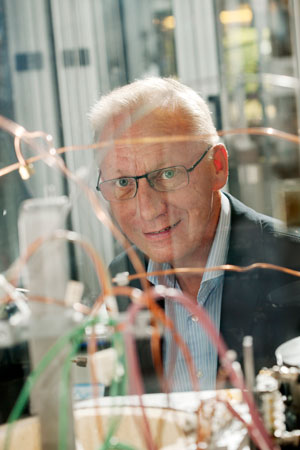Haldor Topsoe has closed Topsoe Fuel Cell, which developed fuel cells together with DTU. Søren Linderoth, Head of Department,
DTU Energy Conversion, discusses the consequences.
In August, Haldor Topsoe announced the closure of Topsoe Fuel Cell, thus calling a provisional halt to fuel cell technology developments. For many years, DTU Energy Conversion has worked closely with Topsoe on the development of fuel cells. So what are the consequences of the closure for DTU? We spoke to Søren Linderoth, Head of Department, DTU Energy Conversion.
What was the relationship between DTU Energy Conversion and Topsoe Fuel Cell?
“Topsoe Fuel Cell can be considered a DTU Energy Conversion start-up. They inherited our technology and signed licence agreements for 40 of our patents. Topsoe Fuel Cell staff were trained here at Risø Campus, where we have a small-scale pre-production plant, and we have worked very closely together,” explains Søren Linderoth.
“Since 1989, we researched and developed Solid Oxide Fuel Cells (SOFC) at Risø Campus—from 2001 in close collaboration with Haldor Topsøe through large, publicly funded projects.
Topsoe Fuel Cells’ development work in electrolytic cells—SOEC or reverse fuel cells—will continue, and the 30 staff who are moving here will still work closely with researchers at DTU Energy Conversion. Haldor Topsoe is actually in the process of creating the world’s largest SOEC plant scheduled for completion in 2015—a project based on our fuel cells— so we are by no means discarding the SOFC technology.”
We have long heard that the fuel cell technology was just around the corner —shouldn’t the technology be mature by now?
“We researchers have long since ceased predicting a date—ultimately, it is up to business to decide when the technology will be available on the market. But it is mature and it must be put into commercial production now.
The American company Bloom Energy produces power-generating units for large companies such as Google, Coca-Cola and Walmart—and Japan has built fuel cell boilers for private households. Denmark is currently testing a Danish-made system at two sites, and the FCH Test Centre—which is based at DTU Energy Conversion—is involved in a European project to test fuel cell plants in 1,000 private homes.
In general, there is a great deal of interest in fuel cells worldwide, and DTU Energy Conversion’s knowledge and expertise in the field is much sought after. In fact, we are currently negotiating with several companies who are interested in working with us now that we are not so closely associated with Topsoe Fuel Cell.”
So DTU Energy Conversion’s SOFC research is set to continue?
“Obviously, the closure of Topsoe Fuel Cell was an unfortunate setback, but I expect us to sign new contracts with international SOFC manufacturers, and SOEC activities will increase given Haldor Topsoe’s increased level of activity in this field.
My competent staff will also be involved in other technology areas within the department. For many years, we have worked with several spin-out technologies based on SOFC research—among them oxygen membranes, flue gas purification, thermoelectric generators, magnetocaloric heat pumps and batteries. Naturally, all of this will continue so we definitely won’t be out of work.”

Interview in DTUavisen no. 8, October 2014.
A fuel cell—Solid Oxide Fuel Cell—converts the chemically bound energy in a fuel (such as natural gas, hydrogen, ethanol, biofuels or diesel) directly into electricity. Among the many benefits are high-efficiency, low emissions and low noise levels.
An electrolytic cell—Solid Oxide Electrolysis Cell— uses electricity to split water molecules into hydrogen and oxygen, for example. The electrical energy is thus transformed into chemically bound energy in the hydrogen molecules, which is the opposite process to what occurs in a fuel cell. SOEC can, for example, be used to store surplus electricity from wind turbines and to produce synthetic fuels.